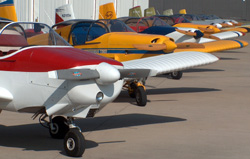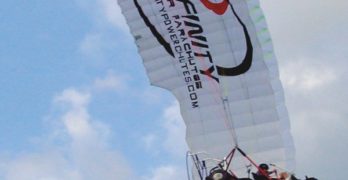I find it ironic that our first new SLSA certification of 2006 is one of the oldest. Welcome to the Taylorcraft Sport as Number 24 in our parade of newly FAA-approved Special Light-Sport Aircraft. A bright red Taylorcraft Sport showed at the Sebring U.S. Sport Aviation Expo last week after winning its approval on January 9th. The taildragger Sport comes with a Continental O-200 100 horsepower engine and without flaps for $69,995, a fairly modest price in this time of Light-Sport Aircraft hitting six figures. Taylorcraft has a rich historical background, starting in 1935 and including a run of thousands of aircraft built. In mid-1946 the company was producing 30 new aircraft a day!…so many that, even today, the majority of Taylorcrafts flying are from that year. Now, buyers can obtain a brand new Sport from the revived company.
Search Results for : MG 21
Not finding exactly what you expected? Try our advanced search option.
Select a manufacturer to go straight to all our content about that manufacturer.
Select an aircraft model to go straight to all our content about that model.
Ramping Up for a New Year of LSA
As we prepare for a new year of Light-Sport Aircraft, companies are ramping up production to assure greater supplies of aircraft. Leading companies have each claimed 2005 deliveries of 20-40 aircraft but are forecasting double to triple that number for 2006. Aircraft such as the Jabiru and Allegro — plus others yet to formally announce their plans — bring component parts to the USA for final assembly complementing U.S. production by companies such as IndUS Aviation (see photo), Legend (building a new plant), and RANS. The new year should be an exciting one, indeed. As the year closes, I’d like to add my voice to those thanking LAMA founder and president, Larry Burke, for his decades of work to nuture the industry organization. He is stepping back — becoming Chairman Emeritus — while myself and Tom Gunnarson take over the reins. THANKS, Larry…for a job very well done!
Leza AirCam Gets New Owners with Ambitious Plans
As mentioned in the SPLOG from Friday Oct. 21st, I have some big news in the world of recreational flying…literally big in the sense of involving the biggest “ultralight” of them all, the AirCam twin. This delightful flying machine, first created by Phil Lockwood and crew, has been languishing under the leadership of investor Antonio Leza who became full owner of the design a few years ago. That’s all about to change when Antonio and Shawn Okun, the ambitious head of Sebring-based Floatplanes & Amphibs, make a detailed announcement at the LAMA/LSA Marketing Group “hospitality tent” during AOPA’s Expo in Tampa November 3-4-5. They will announce that a group assembled by Okun has signed an agreement to take over ownership of Leza AirCam and its building and land lease on the Sebring, Florida airport. Come hear the details at the Peter O.
Air Creation Buggy/Kiss
For many years, I’ve been critical of trike handling. While I try never to forecast the future, I’ve gone out on a limb and predicted that rigid-wings will eventually become commonplace on trikes (though I don’t also predict delta wings will disappear).
Going Rigid?
Rigid-wings look a lot like modern hang gliders and trike wings in many ways, but they have control surfaces. Because these surfaces are deployed via weight-shift movements they neatly combine the benefits of 3-axis ultralights – lower control forces and good control authority – with the elegant simplicity of weight-shift. Rigid-wings can carry good weight and are somewhat faster than delta wings (called “flex wings” by hang glider pilots), and they also handle more easily. I think this makes them a nearly inevitable development.
While I still believe rigid-wings are coming to trikes, it may take longer than I thought because the trike industry may finally be rising to the challenge.
Infinity Power Parachutes
On a warm summer evening, a large field of 3-foot-tall oats sways gently in the breeze. In this pastoral setting a runway is cut down the middle. The farmer who owns this field has a light aircraft he flies from his country property, and he’s kind enough to allow Tim Norling, a local powered parachute pilot, to use it, too. Norling operates Let’s Fly, an Infinity powered parachute dealer 20 miles north of Minneapolis, Minnesota.
By the time Norling gets his Infinity powered parachute set up, the winds have quieted down, as we hoped they might. It is a beautiful evening for flying in Minnesota, and I am ready for a flight.
Some pilots say, “Oh, those powered parachutes are too vulnerable. You can only fly them in gentle winds.” Yeah, so? Is it really imperative to fly in strong winds? Is being restricted to mild conditions a bad thing?
Powered parachutes tend only to be flown when it’s pleasant to do so.
Italy’s Ramphos Flying Boat
Making a Splash
Last year as the flying season began, an unusual flying boat appeared at airshows. The machine was called Ramphos (pronounced RAM-fohss) and it featured a form of ducted prop surrounding a pair of counter-rotating blades. While these two components commanded a lot of attention, they were de-emphasized when the 2004 season arrived.
In 2003, the presentation was market-savvy. By showing a somewhat radical version of the familiar flying boat design – we’ve seen a few of these configurations over the years – the Ramphos attracted attention in a crowded marketplace. When you’re new (to the American public), you need some way to stand out from the crowd.
However, the downside of new, potentially radical ideas is that people – like me – tend to wait until the new concepts prove themselves. So I didn’t fly the Ramphos in 2003. That changed for 2004.
Modern Machine
For the 2004 flying season, the emphasis had been taken off the counter-rotating props, though it was still displayed and remains an option.
Star in Your Sky
The expression “seeing stars” is a good thing, if it means flying a delightful aircraft on a lovely day. After sampling the Sportstar in ’02 (see “Sportstar Pilot’s Report”, December ’02 Ultralight Flying!), I looked forward to a flight in its predecessor, the EV-97 Eurostar. You could say I had stars in my eyes. A blue Florida sky was dappled with miniature cumulus clouds, winds were mild, and the fuel tanks were full in a pretty blue-and-white Eurostar. I was ready.
On a beautiful Saturday, April 17, I flew the Evektor Eurostar with Nick Motlagh (pronounced “MOTE log”) – a sharp young aviator about to embark on a career in the air. He has been accepted to compete for fighter jet training in the Air Force after graduating from Embry Riddle Aeronautical University in Daytona Beach, Florida.
Motlagh had flown the Eurostar (N30167) over to South Lakeland Airpark to allow a flight review.
Blue Heron Marathon
Built lighter to fly better
It may be hard to believe that a company established in 1995 can be considered an old-timer in an industry, yet that’s precisely the case with Heldeberg Designs LLC and its line of Blue Heron powered parachutes (PPCs).
Nick and Marie Viscio founded Heldeberg Designs a decade ago and believe they are the second oldest, continuously operating powered parachute company in America. Only Six Chuter has a longer history under the same management and ownership.
Nick and Marie run the enterprise with help from son Nicholas D., who has a degree in mechanical and aeronautical engineering, and three part-time employees assisting with fabrication and welding. “Nick is very hands-on in operating the company,” said Mark Bayer, Heldeberg’s New York dealer with whom I flew at Sun’n Fun 2004. He added, “They’re not trying to be the biggest manufacturer, just the best.”
Why did the company choose the Blue Heron name for its machines?
Seagull Aerosports takes a new angle
Seagull Aerosports takes a new angle on weight-shift construction with a fully enclosed cockpit.
Developer Michael Riggs might prefer I called his Escape Pod something other than Everyman’s Motorglider, but if you have any interest in self-launched soaring flight, Riggs’ invention is one of the most cost-efficient purchases you can make. The Escape Pod costs thousands less than ultralight motorgliders and literally hundreds of thousands less than sailplane motorgliders.
Oh, and one more thing this kind of flying machine is a hoot to fly. That the Escape Pod also transports easily, can be stored in a small space and is attractively shaped are icing on the cake.
Sure, it’s obvious-I like the Escape Pod. But could it be for you, too? Even if this aircraft isn’t your type, you might enjoy reading about how thoughtfully it was designed.
Trike Motorgliders
Before the Sport Pilot/Light-Sport Aircraft (LSA) rule was recently passed, trike enthusiasts had several other ways to fly such aircraft.
IndUS – Thorpedo
All Revved and Everywhere to Go
This vintage design with a big Jabiru engine is an impressive performer.
Since its reintroduction to the aviation community by IndUS Aviation, John Thorp’s T-211 is generating more attention than at any time since he first designed the airplane.
While John worked on large aircraft, like the Navy patrol bomber P2V Neptune, he focused most of his career on small, sporty aircraft. He began designing a two-place light aircraft in the 1930s. By the 1950s his T-10 Sky Skooter powered by a 50-hp Franklin 2AC-99 engine evolved into the T-111 with a 75-hp Lycoming engine. Later it became the T-211, with a Continental O-200. It is this last version of the T-211 that IndUS now offers as a standard category aircraft. IndUS is also planning to offer the model as a light-sport aircraft (LSA) with a Jabiru 3300 engine, affectionately named the Thorpedo for its improved performance.
- « Previous Page
- 1
- …
- 85
- 86
- 87
- 88
- 89
- …
- 94
- Next Page »











